

 |
||
 |
||
Vol. 9 (2): November 2006 |
||
Algeria / Greece / Italy / Madeira / Mauritania & Western Sahara / Spain / Turkey
Italy
|
||||||||||||||||||
 |
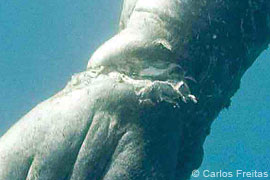 |
|
|
Desertinha with evidence of a deep wound to her hind flippers. |
||
Badly debilitated as a result of the incident, for some days Desertinha stayed at sea, close to a coastal recreation facility of Funchal, where several members of the public came to see her. The area was isolated and the SRRC of Pieterburen dispatched a technician to Madeira to assist in possible rescue efforts.
It was decided to treat the wound, that had become severely infected. Capture at sea therefore had to be attempted, though with the additional safeguard of abandoning the operation if she reacted badly.
The Portuguese Navy, the Whale Museum and the Sea Rescue Association all participated in the operation. However, when Desertinha sensed the boats approaching, she simply moved on. We lost her.
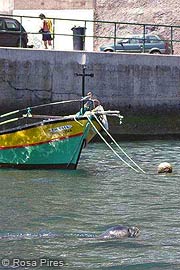 |
|
|
Desertinha, on the mend. |
During these days, Desertinha became a television and newspaper star; very few people on the island can not have heard of her.
And it was that knowledge, particularly among scuba divers, fisherman and others that enabled us to track her. For the first two days, she remained in a sea cave. When we entered, both to confirm her presence and to give her fish containing antibiotics, she again fled the scene.
During the next 13 days, she moved all along the south coast of Madeira and on several occasions we could confirm her recuperation and also that she was feeding by her self, though her posterior area remained inactive.
Since then, she has been observed often at the Garajau Nature Reserve on the south coast. She has recovered the movement in her posterior area but has not yet, it seems, had the confidence to return to the Desertas.
During May and June Desertinha was a frequent topic of discussion among the Madeira people, achieving what we have been trying to do for years within our environmental campaigns: she generated a wave of public solidarity for monk seals and monk seal protection. – Rosa Pires, Parque Natural da Madeira.
During one week in July, a Parque Natural da Madeira (PNMS) trainee and a veterinarian from the Regional Fisheries Department who has been collaborating with the PNMS underwent training on the rehabilitation of seals and necropsies at the Seal Rehabilitation and Rescue Centre (SRRC) in Pieterburen, the Netherlands. – Rosa Pires, Parque Natural da Madeira.
A dead monk seal was discovered floating near Ilhéu Chão in the Desertas Islands Nature Reserve on 14th August. It was identified as a male, with a standard length of 161 cm.
The subsequent necropsy was performed by a veterinarian from the SRRC and a pathologist from the Rotterdam University. Unfortunately, the animal’s advanced state of decomposition did not allow a preliminary diagnosis. However, samples were taken for posterior bacteriological and virological analyses.
Earlier, on the 3rd of August, an injured hooded seal Cystophora cristata was discovered, the first known record of this species in the archipelago. Following a rehabilitation period of 3 days, the seal died, a subsequent necropsy suggesting that the cause had been aspiration pneumonia. – Rosa Pires, Parque Natural da Madeira.
Following an increasing occurrence of monk seals around the main island of Madeira, along with fishermen’s complaints about seals damaging their fishing gear, environmental education became a priority for the PNM service during 2006.
City councils were invited to include in their Blue Flag Programme a talk on “How to behave in a presence of a Monk Seal” aimed at fishermen and others using the sea.
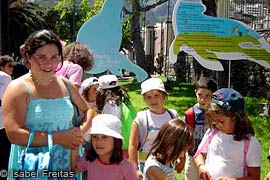 |
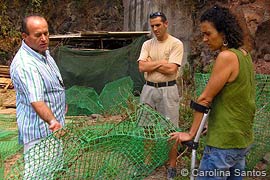 |
|
|
Seal Week in Santa Cruz. |
Talking net damage. The PNM’s Rosa Pires and Marco Camacho, a PNMS ranger, with a Madeiran fisherman. |
In Santa Cruz, where monk seals are more frequently sighted, a monk seal week was held between 22-27 August, during which talks and presentations were held for the general public, along with children’s activities and a travelling exhibition.
Meanwhile, contacts with fishermen were also established in order to demonstrate our concern and also to discuss possible solutions to the issue of seal damage to fishing gear. – Rosa Pires, Parque Natural da Madeira.
Prior to the mass die-off that decimated the Cabo Blanco monk seal population in 1997, an average of 52 births took place in the breeding caves each year. Following that catastrophic event, when an estimated 200 of the 350 animals of the population died, the productivity of the colony decreased to 24 pups in 1998.
Since the launch of conservation efforts in the area in 2000, under the framework of the Action Plan for the Recovery of the Monk Seal in the Eastern Atlantic (CMS/UNEP), the population has shown hopeful signs of recovery [see Hopeful signs at Cabo Blanco, TMG 7 (1): June 2004].
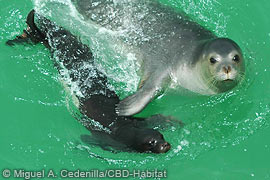 |
|
|
Mother and pup at Cabo Blanco. |
Following the establishment of a no-fishing zone in 2001 and the elimination of disturbances in the vicinity of the breeding caves, the number of animals (except pups) found dead on the beaches south of the colony has notably decreased, and the number of animals using the breeding caves and the number of adult males occupying territories near the reserve have increased.
During the years following the die-off, the productivity has slightly increased, from 24 pups born in 1998 to 29 in 2004 and 2005. However, this year (2006) the number of births has notably increased, with 46 pups having been born so far this season. Since monitoring in the breeding caves is similar to other years, this increase cannot be attributed to changes in the level of human effort. This year, identified females with no reproductive history have been observed with a pup, possibly their first one. Although the reproductive season has not yet ended, and data need to be analysed and filming records reviewed, the increase in productivity seems to be the result of the incorporation of new females into the reproductive fraction of the population.
The increase in productivity at the colony was an anticipated event, and one that will undoubtedly contribute to a faster recovery of the Cabo Blanco monk seal population. – Miguel Angel Cedenilla and Pablo Fernández de Larrinoa, CBD-Habitat Foundation.
Mediterranean News continues with Spain and Turkey...
Copyright © 2006 The Monachus Guardian. All Rights Reserved |